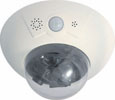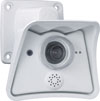

On-camera technology is taking on analysis work and leaving resources in the control centre free for more productive security operations.
In today’s security market there is a strong migration towards technology integration. End users are expecting more from the convergence of security, building and information technology systems. Information display and control needs to be simply and effectively achieved at single points of access. This trend applies to virtually all vertical markets and from small enterprise installations to large campuses.
Technology companies believe that, in line with these trends, end users of surveillance products are looking for more than just digital video recording. Related information from other systems such as access control systems, POS terminals, alarm panels and just about any other digital device capable of outputting information needs to be presented and analysed together with visual data. Key information needs to be collated, analysed and distributed to strategic decision makers.
Key aspects of new technologies are:
* The use of high resolution video systems.
* Advanced decentralised decision making software with comprehensive reporting tools.
The decentralised concept becomes more and more important in today’s technology world. You want to sit in Mauritius and look at your sites.
Unlike other systems, the decentralised concept incorporates a high-speed computer and, if necessary, a digital memory (SD card) for long-term recording in every camera. The PC is now used only for viewing, not for analysis or recording. As a result, these high-end cameras can record events even without a running PC and digitally record videos with sound for archiving purposes.
The concept nowadays is moving to software analysis at the monitoring point and then send the results (answers) to the control room. This concept empowers the end user to have access to monitoring functions and it saves money on expensive bandwidth.
Usually, in the older centralised solutions, cameras only supply the images while the processing and recording is done later on a central PC using video management software. This traditional centralised structure is unsuitable for high-resolution video systems, since it requires not only high network bandwidth, but also needs enormous PC processing power to support several cameras.
An HDTV MPEG4 film already puts considerable strain on a PC, so how can it be expected to process dozens of high-resolution live cameras? Traditional centralised systems are therefore neither cost-efficient nor suitable due to the large number of PCs required for high-resolution systems.
The higher the resolution, the more details are in an image. Using traditional (analogue) technology, a live image has no more than 0,4 megapixels and a recorded image only has 0,1 megapixels (CIF). On the contrary, a High Resolution camera with 3,1 megapixels records around 30 times more detail. As a result, larger image areas with up to 360° panorama are possible, thus reducing the number of cameras and therefore the costs. For example, four lanes of a gas station can be recorded using one high resolution camera instead of four conventional cameras.

The benefits
High-resolution video solutions therefore require significantly:
* Fewer cameras due to the more accurate detail of wide-angle images with megapixel technology.
* Fewer PCs/DVRs, because around 40 cameras can store high-resolution video with sound efficiently on a single PC, or no PC at all when recording on the camera’s digital storage (USB, SD card).
* Lower network bandwidth, because everything is processed in the camera itself and the high-resolution images therefore do not have to be constantly transferred for analysis.
With technology like 3G and other broadband infrastructure modern technology can help security surveillance systems to be more proactive than reactive. You can play pre-recorded messages over the infrastructure to delay perpetrators in whatever they have on their devious agenda.
For more information contact Burg van der Westhuizen, Industrial Automation & Control, +27 (0)12 657 3600, [email protected]
| Tel: | +27 12 657 3600 |
| Email: | [email protected] |
| www: | www.iacontrol.co.za |
| Articles: | More information and articles about Industrial Automation & Control (IAC) |
© Technews Publishing (Pty) Ltd. | All Rights Reserved.